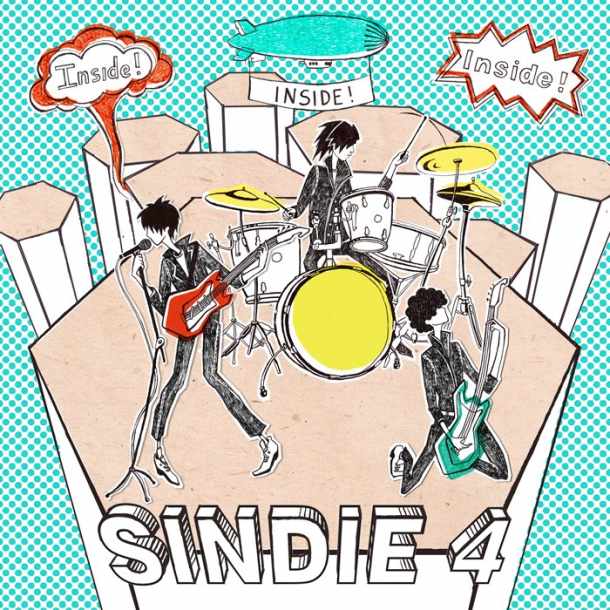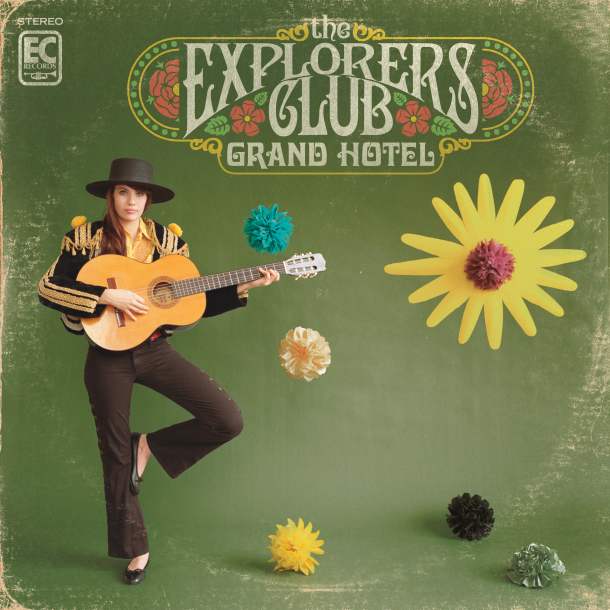
by Jay Mattson
Unless you’ve been listening strictly to Top-40 radio for the past five years, you’ve probably heard of Sufjan Stevens. Though he hasn’t garnered any true mainstream success, he has been a staple of hipster-kid mentality for nigh a decade. His last release, 2005’s Illinois (sometimes called Come on Feel the Illinois) was the last time Stevens released a proper album. Since his rise to indie popularity, Stevens has released six…wait…seven? Christmas albums, a record of Illinois b-sides and alternate versions, a fuzzed-out soundtrack called The BQE, a full re-rendition of a previous electronic album, and various singles throughout it all. Now, five years and a heap of superfluous work later, Stevens is finally releasing an actual album! Abandoning his overly-tenacious “50 States Project”, and going through some rather public digression away from the idea of an “album” or “song”, Stevens has put together the monstrous, the epic, the grandiose The Age of Adz.
Like any faithful indie music lover, I’ve stuck by Stevens. I immensely enjoyed 2003’s Michigan and, of course, Illinois. These two albums pushed me to go backwards into Stevens’ catalogue and experience all of his former endeavors. And while I honestly thought Michigan and Illinois were his two best works, I still held all his work in high esteem; here was a man who knew exactly what he wanted and how he wanted to express it. It was truly inspiring. In fact, I finagled my way into seeing Stevens live at the Memorial Hall on campus at the University of North Carolina in early 2006. I, like many, was completely taken by Stevens’ talent, technicality, and mood.
Moving forward, I never felt Stevens was able to capture the true breadth of Illinois in any subsequent work, but I reconciled my feelings with the fact that all of these works were either alternate versions, re-interpretations or pet-projects. The new album is a shining testament to his talent and grandiose musical nature, but with The Age of Adz, it feels like, for the first time, Stevens is somewhat lost; he knows what he wants to say, just not how to say it. While Illinois succeeded in containing potential chaos and turning it into breathtaking songs (which created an amazing album), Adz feels like all the acts of Cirque du Soleil mashed together, each part trying vigorously to stand apart from the rest. Adz is fantastic, but not in the traditional ‘Sufjan Stevens’ way.
Two singles from Adz, “I Walked” and “Too Much”, have been floating around the interwebs for about a month now. “I Walked” was released around the same time as the fantastic All Delighted People EP, which was a genius move by Stevens; give fans a collection of songs more akin to previous work whilst also introducing a new chapter in his musical career.
Oddly, these two singles are the most cohesive on the entire album. Within eleven tracks, Stevens has attempted to combine the culmination of five years of experimentation, self-reflection and personal growth. Instead of full-fledged orchestral rumblings, Stevens has opted to use electronics for The Age of Adz. Anyone expecting a spiritual successor to Illinois might be disappointed. The album begins with a rather minimal string arrangement in “Futile Devices”, like a deep breath before a plunge into the depths of electronic inclinations. The aforementioned “Too Much” follows, and does so with liquid-y electronics swerving to-and-fro to give a feeling of melancholy whimsy. Stevens has traded in his backing band for synthesizers.

The title track is where things get a little congested. “The Age of Adz” begins with a rather harrowing combination of sonic blasts coupled with horns and a flighty flute. Definitely one of the darker tracks on the album, this eight-minute epic feels like it can’t decide whether it wants to be foreboding or calming, switching quickly from a mess of synthesizers to just vocals and a rumbling undertone. This back-and-forth makes it difficult to simply enjoy the song, instead trying to ‘figure it out’ and catch all the minuscule details constantly fluttering around. “I Walked” brings things back to a more even keel with more tempered melodies and a feel closer to Illinois and Michigan, complete with choral arrangements. It’s interesting how Stevens creates such pastoral emotions while working with primarily modern technology.
“Now That I’m Older” evokes a bizarrely estranged nostalgia; it feels familiar, if only like it should. With a swelling chorus, Stevens’ voice seems to sound worse than it actually should while also falling into disarray. It’s odd that “Get Real Get Right” follows, as its overtly playful attitude is very much at odds with “Older”, again to puzzling conclusions. This might be one of Stevens’ most straightforward, bland songs to date with lyrics, “I know you want it, you really want it.” “I know what caused you trouble, I know what caused you pain”, sounds like something out of the post-Blue Album-era Weezer lyrical handbook. More than anything, Stevens sounds self-deprecating, painting himself as a victim more often than not. And yes, many times in music, there is a theme of hopelessness, sadness and victimization, but here, it just sounds whiny, not intuitive and thoughtful.
Thankfully, “Vesuvius” comes on strong with an underlying frailty. Keeping the synths reserved to a minimum, Stevens has crafted an excellent melody that sounds collective in production and in execution. For the first time on the entire album, this song sounds like it would work well on a grander, orchestral scale fitting of live treatment. Unfortunately, “All for Myself” bogs down the mood before moving into the absolutely frantic and uncharacteristic “I Want to be Well.” Instead of the upbeat songs sounding emotional and inspiring, they have come off as pretentious and unnecessary. With songs like these, Stevens has resigned to following the popular musical tendencies instead of shaping them, which disappoints me.
I could write an entire article on “Impossible Sound”, the 25+ minute closing track. This song goes through as many movements as some entire albums. Stevens is nothing but epic, and this songs proves it. Beginning with drum and searing electric guitar, it moves through laser shots with chorus, minimal horns, AUTO-TUNED SUFJAN, spider-like synths, marching band-esque chanting, and a few others before ending with a simple guitar melody. It is impressive and exhaustively beautiful, yet keeps the same up-and-down aesthetic of the first ten tracks.
The Age of Adz is interesting. Usually, this sentiment is thought of as cliche, overused and over-simplistic. Here, though, I feel ‘interesting’ wholly describes an album that is very, very difficult to pinpoint. It jumps back and forth, takes the audience through multiple journeys of electronic experimentation as well as a walk down memory lane, all with five years of contemplation under Stevens’ belt. Sometimes it pops and shimmers, and sometimes it feels overworked and under-thought. Overall, I find myself hesitant to listen to it, but unable to stop once I do.
7.0/10.0
RIYL: Andrew Bird, Iron & Wine, Bon Iver,Grizzly Bear, Ferraby Lionheart, St. Vincent, Broken Social Scene, The Decemberists, Pinback, The National, The Books, The Dodos






great review, and great songs to boot. gotta agree that the album isnt a entire success tho
Sufjan Stevens – “Too Much”
Definitely a unique sound. Can’t tell if it works for me or not…
But considering that I’ve just about listened to the whole song…I’d say it’s leaning more on the “working” versus “not working”.
Let’s just stamp it as “interesting” for now. =)
I love the album. It took me a while to really get into it, but when I gave it time it really grew on me. I completely agree with the last sentence. Not my go to album this year, but I enjoy it when I listen. Great review.
“I Walked”
Ok…so I had to give a listen to another song since I was on the fence about the last one.
This one is a bit better, but stays kinda of monotone…no “high” points or creative variation throughout the song. But it’s easy listening (and again, I’ve listened to the whole song…). =)
try “Vesuvius” as well. i think that one may be my favorite
It’s funny, I disagree with you about everything, this is easily one of the candidates for album of the decade for me, but it was still a great review. As a reader, you just have to look away from some of it and decide for yourself. Get Real, Get Right is for example one of the best songs on the album, and Vesuvius one of the worst.
it’s certainly a very polarizing album. i can see both why someone would worship it and despise it to death. certainly not an easy record to review, but I agree with you that it was a very well-put review.
Sounds like an soviet keyboards;)
But I like it;)
Love it!
Nice review! Great tracks! Really dig “Too Much”.
I enjoyed two of the three songs very throughly, but the third one I felt was just… “Too Much.” Sorry, I had to but I felt like that song was extremely disorganized. Some bands pull off the whole post-everything sound very well, but Surfjan did not. Good post though. A welcome break from ‘normal’ music.
This album is one of the best this year, in my opinion, but it has a little too much electronic static. Stevens sometimes seems to just add it in for the same of Radiohead-ing his sound. I would have preferred a little more purity, like in the first song, “Futile Devices”
My favorite track of this album was Impossible Soul for sure.
Im not too crazy about the middle of the song but the beginning and ending of it were completely epic.
I love that Sufjan went in this direction, I wasnt so surprised since I was already an avid listener of Enjoy Your Rabbit.
This album has its moments that are reminiscent of Illinois or Chicago though and I love that.
The old stuff is best. This just sounds too forced, like he knew he needed to make a new album. I much prefer the old Sufjan and don’t really care for what he’s creating nowadays. Whenever I listen to him now I just think of egotistical musicians who explode to fame overnight after creating an off putting album which fits the needs of douchebag listeners.